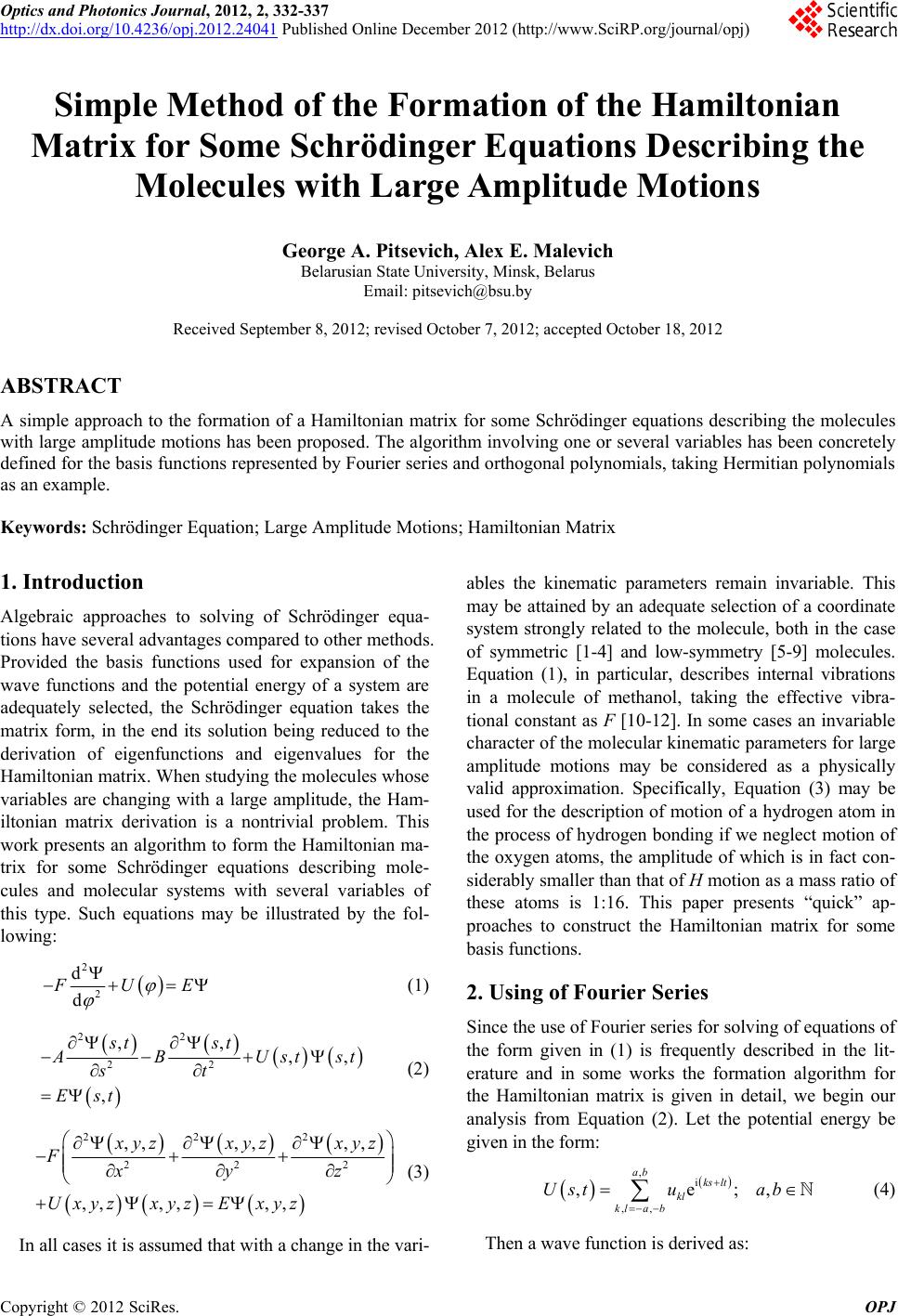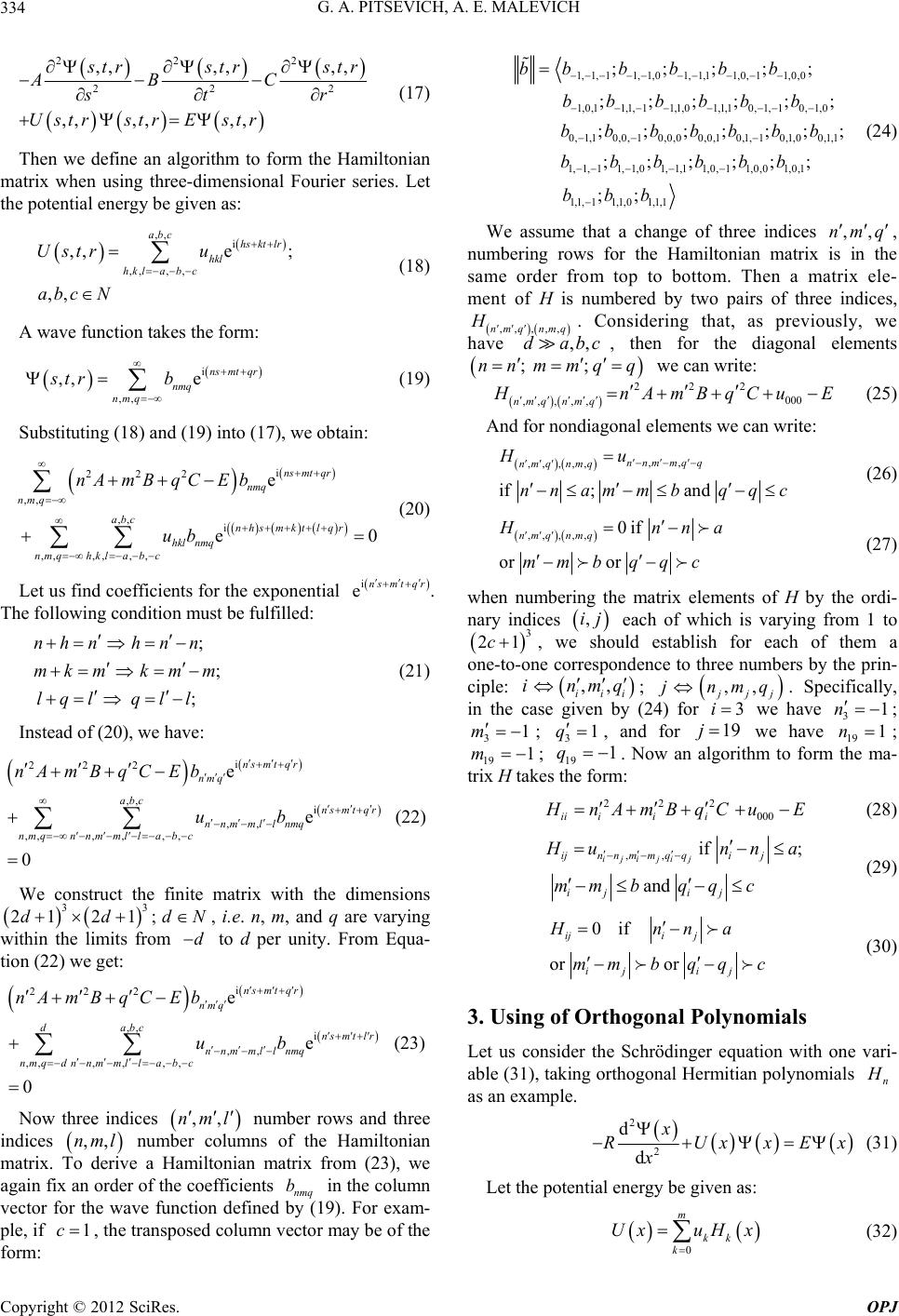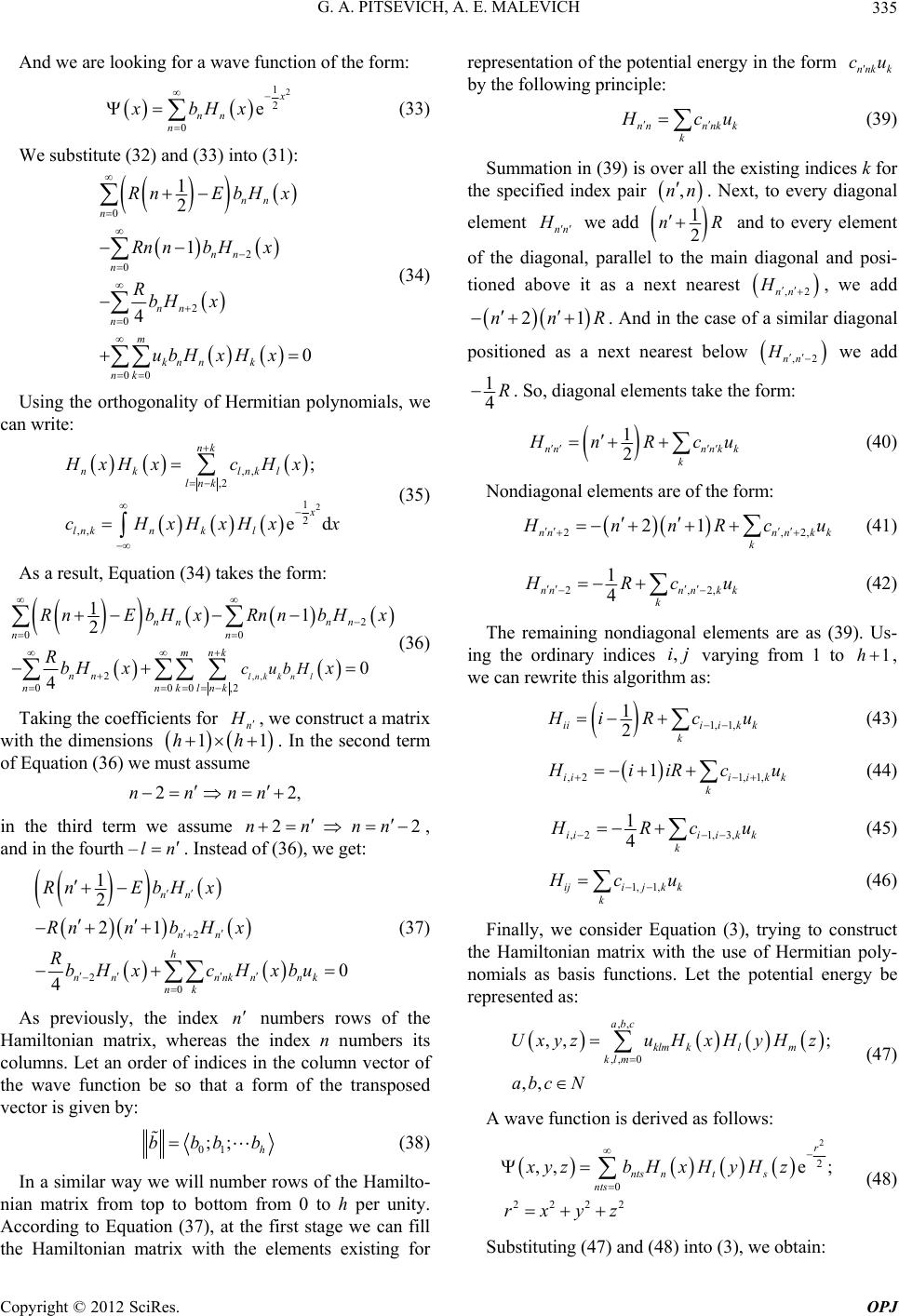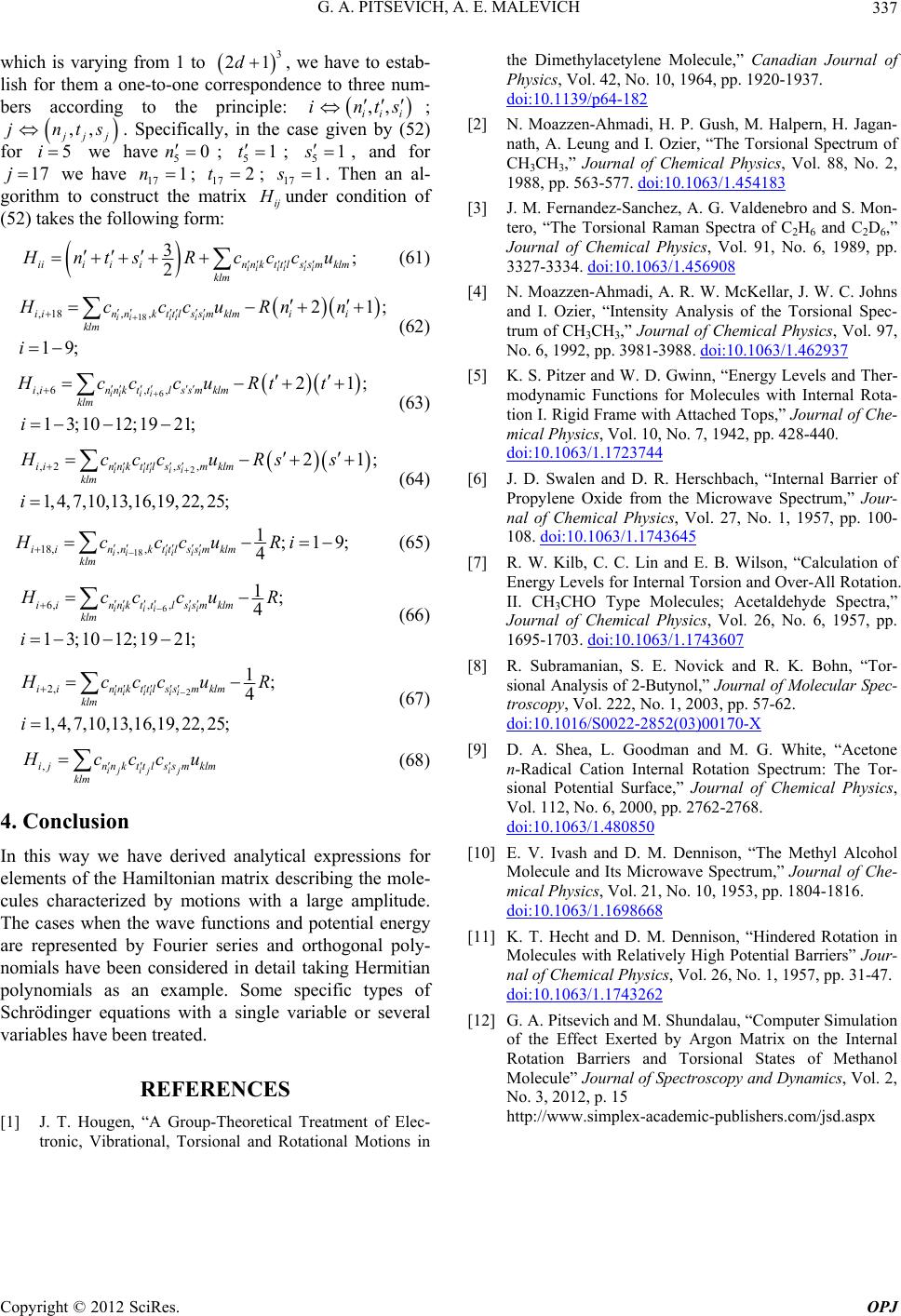 Optics and Photonics Journal, 2012, 2, 332-337 http://dx.doi.org/10.4236/opj.2012.24041 Published Online December 2012 (http://www.SciRP.org/journal/opj) Simple Method of the Formation of the Hamiltonian Matrix for Some Schrödinger Equations Describing the Molecules with Large Amplitude Motions George А. Pitsevich, Alex E. Malevich Belarusian State University, Мinsk, Belarus Email: pitsevich@bsu.by Received September 8, 2012; revised October 7, 2012; accepted October 18, 2012 ABSTRACT A simple approach to the formation of a Hamiltonian matrix for some Schrödinger equations describing the molecules with large amplitude motions has been proposed. The algorithm involving one or several variables has been concretely defined for the basis functions represented by Fourier series and orthogonal polynomials, taking Hermitian polynomials as an example. Keywords: Schrödinger Equation; Large Amplitude Motions; Hamiltonian Matrix 1. Introduction Algebraic approaches to solving of Schrödinger equa- tions have several advantages compared to other methods. Provided the basis functions used for expansion of the wave functions and the potential energy of a system are adequately selected, the Schrödinger equation takes the matrix form, in the end its solution being reduced to the derivation of eigenfunctions and eigenvalues for the Hamiltonian matrix. When studying the molecules whose variables are changing with a large amplitude, the Ham- iltonian matrix derivation is a nontrivial problem. This work presents an algorithm to form the Hamiltonian ma- trix for some Schrödinger equations describing mole- cules and molecular systems with several variables of this type. Such equations may be illustrated by the fol- lowing: 2 2 d d UE (1) 22 22 ,, ,, , st st BU stst st Est (2) 222 222 ,,,, ,, ,, ,,,, yzxyz xyz Fxyz U xyzxyzExyz (3) In all cases it is assumed that with a change in the vari- ables the kinematic parameters remain invariable. This may be attained by an adequate selection of a coordinate system strongly related to the molecule, both in the case of symmetric [1-4] and low-symmetry [5-9] molecules. Equation (1), in particular, describes internal vibrations in a molecule of methanol, taking the effective vibra- tional constant as F [10-12]. In some cases an invariable character of the molecular kinematic parameters for large amplitude motions may be considered as a physically valid approximation. Specifically, Equation (3) may be used for the description of motion of a hydrogen atom in the process of hydrogen bonding if we neglect motion of the oxygen atoms, the amplitude of which is in fact con- siderably smaller than that of H motion as a mass ratio of these atoms is 1:16. This paper presents “quick” ap- proaches to construct the Hamiltonian matrix for some basis functions. 2. Using of Fourier Series Since the use of Fourier series for solving of equations of the form given in (1) is frequently described in the lit- erature and in some works the formation algorithm for the Hamiltonian matrix is given in detail, we begin our analysis from Equation (2). Let the potential energy be given in the form: ,i ,, ,e;, ab ks lt kl kla b Ustu ab (4) Then a wave function is derived as: C opyright © 2012 SciRes. OPJ  G. А. PITSEVICH, A. E. MALEVICH 333 i , ,e ns mt nm nm st b (5) Substituting (4) and (5) into (2), we obtain: i 22 , ,i ,,, e e0 ns mt nm nm ab nks mlt kl nm nmkla b nA mBEb ub (6) Next we define coefficients for the exponential . In the second term the following condition must be fulfilled: i ensmt ;nk nk n n ml ml mm (7) Instead of (6), we have: i 22 ,i , ,,, e e0 ns mt nm ab ns mt nnmmnm nmn nmma b nA mBEb ub N (8) Then we construct the finite matrix with the dimen- sions . This means that n and m are varying within the limits from to c per unity. From (8) we derive: 22 21 21;ccc c i 22 ,i , ,,, e e0 ns mt nm ab cns mt nnmmnm nmcnnm ma b nA mBEb ub (9) Now we take (9) as a matrix equation of the form ij jj j bEb, where j b—column vector that, ac- cording to (5), gives the wave function corresponding to the energy . It is clear that a pair of the indices ,nm numbers rows of the Hamiltonian matrix and a pair of the indices ,nm b —its columns. Next, to derive the Hamiltonian matrix from (9), first we have to fix an order of the coefficients nm in the column vector of the wave function defined by Equation (5). For example, if , the transposed column vector may be of the form: 1c 1, 11,01,10,10,00,11,11,01,1 ;;;;;;;;b bbbbbbbbb (10) Let us assume that in the same order from top to bot- tom there is a change in the index pair ,nm ,ab num- bering rows of the Hamiltonian matrix. Then a matrix element of H is numbered by two index pairs, ,,,nmnm. Considering that usually, for the diagonal element H c ;nnmm we can write: 22 00 ,,,nm nm nAmB uE (11) and for nondiagional elements we can write: , ,,, if and nnmm nm nm Hu nna mmb (12) ,,, 0 if or nm nm H nna mmb (13) Numbering matrix elements of by the ordinary indices ,ij 2 each of which is varying from 1 to , we should establish for each of them a one- to-one correspondence to a pair of numbers by the prin- ciple: 21c ,in ii m ; , jj nm 3i. Specifically, in the case given by (10) for we have ; 33 1n 1m ; and for 6j we have 6; 6. Now an algo- rithm for the formation of the matrix 0n1m takes the fol- lowing form: 22 00ii ii nA mBuE (14) , if and ijij ijnn mm iji j Hu nnamm b (15) 0if or iji jij Hnnamm b (16) Let us write the Hamiltonian matrix in the explicit form with the use of (14 - 16) for . Besides, we assume that the index order is determined by the relation of (10), and 1c 1ab . Then we have: 0, 11,01,1 00 0,10, 11,11,01, 1 00 0,11,11,0 00 1,01,10, 11,01,1 00 1,11,01, 10,10, 11,11,01, 1 00 1,1 1,00,11,1 1,0 00 1,0 1 0000 000 0000 00 000 000 uuu ABu uuuuu Au uuu ABu uuu uu Bu uuu uuuuu u uu uuu Bu uu ,1 0,1 00 1,11,01, 10,10, 1 00 1,1 1,00,100 00 000 0000 0 u ABu uuu uu Au uu u 0 0 0 Bu Next we consider the case of three variables. Let the Schrödinger equation be of the form: Copyright © 2012 SciRes. OPJ  G. А. PITSEVICH, A. E. MALEVICH 334 222 22 ,, ,,,, ,, ,,,, 2 tr str str ABC st U strstrEstr r (17) Then we define an algorithm to form the Hamiltonian matrix when using three-dimensional Fourier series. Let the potential energy be given as: ,, i ,,, , ,,e ; ,, abc hs kt lr hkl hkl abc Ustr u abc N (18) A wave function takes the form: i ,, ,, ens mt qr nmq nmq str b (19) Substituting (18) and (19) into (17), we obtain: i 222 ,, ,, i ,,,,,, e e0 ns mt qr nmq nmq abc nhsmktlqr hkl nmq nmqhklabc nA mB qCEb ub (20) Let us find coefficients for the exponential i ens mt qr . The following condition must be fulfilled: ; ; ; nhnhn n mk mk m m lqlql l (21) Instead of (20), we have: i 222 ,, i ,, ,,,,, , e e 0 ns mt qr nmq abc nsmt qr nnmmllnmq nmqn nm ml labc nA mB qCEb ub N (22) We construct the finite matrix with the dimensions , i.e. n, m, and q are varying within the limits from to d per unity. From Equa- tion (22) we get: 33 21 21;ddd d i 222 ,, i ,, ,,,,, , e e 0 ns mt qr nmq abc dns mt lr nnmmllnmq nmqdnnmmllabc nA mB qCEb ub (23) Now three indices ,,nml number rows and three indices ,,nml 1c number columns of the Hamiltonian matrix. To derive a Hamiltonian matrix from (23), we again fix an order of the coefficients nmq in the column vector for the wave function defined by (19). For exam- ple, if , the transposed column vector may be of the form: b 1, 1, 11, 1,01, 1,11,0, 11,0,0 1,0,11,1, 11,1,01,1,10, 1, 10, 1,0 0, 1,10,0, 10,0,00,0,10,1, 10,1,00,1,1 1, 1, 11, 1,01, 1,11,0, 11,0,01,0,1 1, ;;;;; ;;;;;; ;;;; ;; ;;;;;; bb bbbb bb bbbb bbbbbbb bbbbbb b ; 1, 11,1,01,1,1 ;;bb (24) We assume that a change of three indices ,,nmq , numbering rows for the Hamiltonian matrix is in the same order from top to bottom. Then a matrix ele- ment of H is numbered by two pairs of three indices, ,, . Considering that, as previously, we have , then for the diagonal elements ,,,nmq nmq H d ,,abc q ;;mqnnm we can write: 222 000 ,,,,,nmq nmq nAmBqCu E (25) And for nondiagonal elements we can write: ,, ,, ,,, if ;and nnmmq q nmq nmq Hu nnammb qqc (26) ,, ,,,0if or or nmq nmq nna mmb qqc (27) when numbering the matrix elements of H by the ordi- nary indices ,ij each of which is varying from 1 to 3 21c , we should establish for each of them a one-to-one correspondence to three numbers by the prin- ciple: q,, ii inm i ; ,, jjj nmq 3i . Specifically, in the case given by (24) for we have 31n ; 31m ; 31q , and for we have 19 19j1n ; 19 1m ; 19 1q . Now an algorithm to form the ma- trix H takes the form: 222 000 ii iii nA mB qCuE (28) ,,if ; and iji jij ijnn mm qqij ij ij unn mm bqq c a (29) 0if or or iji j ij ij Hnna mmb qqc (30) 3. Using of Orthogonal Polynomials Let us consider the Schrödinger equation with one vari- able (31), taking orthogonal Hermitian polynomials n as an example. 2 2 d d x RUxxE x x (31) Let the potential energy be given as: 0 m kk k UxuH x (32) Copyright © 2012 SciRes. OPJ  G. А. PITSEVICH, A. E. MALEVICH 335 And we are looking for a wave function of the form: 2 1 2 0 e nn n xbHx (33) We substitute (32) and (33) into (31): 0 2 0 2 0 00 1 2 1 4 0 nn n nn n nn n m kn nk nk RnEbH x Rnnb Hx RbH x ubHx Hx (34) Using the orthogonality of Hermitian polynomials, we can write: 2 ,, ,2 1 2 ,, ; ed nk nk lnkl lnk x lnknk l HxHxc Hx cHxHxH xx (35) As a result, Equation (34) takes the form: ,, 2 00 2 000,2 11 2 0 4lnkk nl nn nn nn mnk nn nnklnk cubH RnEbH xRnnbHx RbH xx (36) Taking the coefficients for n , we construct a matrix with the dimensions 1h1 , h. In the second term of Equation (36) we must assume 22nnnn in the third term we assume , and in the fourth –. Instead of (36), we get: 22nnnn ln 2 2 0 1 2 21 0 4 nn nn h nnnnkn nk nk RnEbHx Rnnb H x RbHx cHxbu (37) As previously, the index numbers rows of the Hamiltonian matrix, whereas the index n numbers its columns. Let an order of indices in the column vector of the wave function be so that a form of the transposed vector is given by: n 01 ;; h bbbb (38) In a similar way we will number rows of the Hamilto- nian matrix from top to bottom from 0 to h per unity. According to Equation (37), at the first stage we can fill the Hamiltonian matrix with the elements existing for representation of the potential energy in the form by the following principle: nnk k cu nnnnk k k cu (39) Summation in (39) is over all the existing indices k for the specified index pair ,nn . Next, to every diagonal element nn we add 1 2 nR and to every element of the diagonal, parallel to the main diagonal and posi- tioned above it as a next nearest ,2nn H , we add 21nn R . And in the case of a similar diagonal positioned as a next nearest below we add ,2nn H 1 4R. So, diagonal elements take the form: 1 2 nnnnkk k nRcu (40) Nondiagonal elements are of the form: 2, 21 nnn nkk k2, nnRc u (41) 2, 1 4 nnn nkk k2, Rcu (42) The remaining nondiagonal elements are as (39). Us- ing the ordinary indices varying from 1 to ,ij 1h , we can rewrite this algorithm as: 1, 1, 1 2 iiiik k k iRcu (43) ,21, 1, 1 iiiik k k iiR cu (44) ,2 1,3, 1 4 iiiikk k Rc u (45) 1, 1,ijijk k k cu (46) Finally, we consider Equation (3), trying to construct the Hamiltonian matrix with the use of Hermitian poly- nomials as basis functions. Let the potential energy be represented as: ,, ,, 0 ,, ; ,, abc klm klm klm Uxyzu HxH yHz abc N (47) A wave function is derived as follows: 2 2 0 2222 ,,e ; r nts nts nts xyzb HxHyHz rxyz (48) Substituting (47) and (48) into (3), we obtain: Copyright © 2012 SciRes. OPJ  G. А. PITSEVICH, A. E. MALEVICH 336 0 2 0 2 0 2 0 2 0 2 0 2 0 3 2 (1) 1 1 4 4 4 nts nts nts nts nts nts nts nts nts nts nts nts nts nts nts nts nts nts nts nts nts fnk ht RntsEbHxHyHz Rn nbHxHyHz Rt tbHx Hy Hz Rs sbHx Hy Hz RbHxH yH z RbHxHyH z RbHxH yHz cc 00 0 abc lrsmntsklm fhr nts klmfhr cbuHxHyHz (49) Suppose that we need to construct a matrix with the dimensions . We determine coeffi- 3 1dd 3 1 cients for the factor : nts xH yH z 2,, ,2, ,, 2 2,, ,2, ,,2 3 2 21 21 21) 4 4 4 nts nts ntsn ts nts nts nts nts ntsn ts nts nts nt s Rnt sEb H xHyHz RnnbHxH yH z RttbHxH yHz RssbH xH yH z RbHxHyHz RbHxHyHz RbH 0 0 nts d nnk ttlssm ntsklmnts nts klm xH yHz cccbuHxHyHz (50) This expression may be rewritten as follows: 2, ,,2, ,,22,,, 2, ,, 2 0 3 2 21 21 21 44 0 4 nts n nts nts ntsntsnts d ntsnnkt tls smntsklm nts klm Rn tsEbHx Rnn bRttb RR Rssbbb Rbcccbu (51) We fix an order of the coefficients nts in the column vector of the wave function defined by Equation (48). For example, if , the transposed column vector may be of the form: b 2d 0,0,0 0,0,10,0,2 0,1,0 0,1,10,1,2 0,2,0 0,2,1 0,2,21,0,01,0,11,0,2 1,1,01,1,11,1,21,2,0 1,2,1 1,2,2 2,0,0 2,0,12,0,2 2,1,0 2,1,12,1,2 2,2,0 2,2,12,2,2 ;;;;;;;; ;;;;;;;;; ;; ;;;; ;; bbbbbbbbb bbbbbbbbbb bbbbbbbbb ; (52) Let us assume that a change in three indices ,,nts numbering rows of the Hamiltonian matrix is in the same order from top to bottom. The matrix element is numbered by a pair of three indices ,,, ,,nts nts. As earlier, first we can fill the Hamiltonian matrix with the existing elements representing the potential energy of the form by the following principle: H n nkttls smklm cccu ,,, ,,n nkt tls smklm nts ntskl m cccu (53) Summation in Equation (53) is performed over all the existing triples ,,klm for the pair of the specified triples ,,nts and ,,nts. For the main diagonal ,, ,,,nts nts H we must add 3 2 nts R . To the nondiagonal elements of the form ,, ,2,,; nts nts H ,, ,2,,nts nts H , and we must add ,, , ,,2nts nts H 21Rn n ; 21Rt t , and 2Rs s1 . Finally, to the diagonal elements of the form ,, ,nts n H 2,,; ts H ,, ,,2,nts nts H , and ,, , ,,2nts nts we must add 1R. Thus, we have: 4 ,, ,,, 3 2 nts nts nnk ttlssm klm klm nts R cccu (54) ,2, ,, ,2,, 21 nnk ttl ssm klm nts ntskl m cccu Rn n (55) ,2, ,, ,,2, 21 nnkt tlssmklm nts ntskl m cc cu Rt t (56) ,2, ,, ,,,2 21 nnkttls smklm nts ntsklm cccu Rs s (57) 2, , ,, ,2,, 1 4 nn kttlssmklm nts ntsklm cccu R (58) ,2, ,, ,,2, 1 4 nnkt tlssmklm nts ntsklm cc cuR (59) ,, , ,,2 1 4 nnk ttl ssm klm nts ntsklm cccu R (60) In other cases, we have (53). Now numbering the ma- trix elements of H by the ordinary indices ,ij each of Copyright © 2012 SciRes. OPJ  G. А. PITSEVICH, A. E. MALEVICH Copyright © 2012 SciRes. OPJ 337 which is varying from 1 to , we have to estab- lish for them a one-to-one correspondence to three num- bers according to the principle: 3 21d ,, ii i ints ; ,, jjj nts 5i 17j . Specifically, in the case given by (52) for we have; ; , and for we have 17 ; 17 50n 1t51t 2 51s n ; 17 . Then an al- gorithm to construct the matrix under condition of (52) takes the following form: 1s ij H iii i Hnt ,18 , 19 ; ii iin n klm Hc i ,6 13 ;10 1 ii ii nnk klm Hc i ,2 1, 4, 7,10,13 ii ii nnk klm Hc i 3 2 i s 18 ,ii k ttl s 6 , , 2;1921 i i t tlss c 2 , 16,19, 22 iii i ttls s cc ; ii ssm klm cu 21; i nn 21;tt 21;ss ii ii nnk ttl klm cc m klmi cu klm uR 25; klm uR R ii s ; m c , , m (61) c R (62) (63) , (64) 18 ,ii nkttl c 18, , ii iin klm Hc 1 4 klm u;1 9;Ri i s i sm c (65) 6 , , 2;1921 i ii kttls6, 13 ;101 ii ii nn klm 1 4 ; i smklm ; cc c u R i (66) 2 16,19,22 iiii ttl ss2, 1, 4, 7,10,13 ii i innk klm 1 4 ,,25; m klm; ccc ij ij ttl ssm uR i ,ij ij nnk klm (67) klm ccc u (68) 4. Conclusion In this way we have derived analytical expressions for elements of the Hamiltonian matrix describing the mole- cules characterized by motions with a large amplitude. The cases when the wave functions and potential energy are represented by Fourier series and orthogonal poly- nomials have been considered in detail taking Hermitian polynomials as an example. Some specific types of Schrödinger equations with a single variable or several variables have been treated. REFERENCES [1] J. T. Hougen, “A Group-Theoretical Treatment of Elec- tronic, Vibrational, Torsional and Rotational Motions in the Dimethylacetylene Molecule,” Canadian Journal of Physics, Vol. 42, No. 10, 1964, pp. 1920-1937. doi:10.1139/p64-182 [2] N. Moazzen-Ahmadi, H. P. Gush, M. Halpern, H. Jagan- nath, A. Leung and I. Ozier, “The Torsional Spectrum of CH3CH3,” Journal of Chemical Physics, Vol. 88, No. 2, 1988, pp. 563-577. doi:10.1063/1.454183 [3] J. M. Fernandez-Sanchez, A. G. Valdenebro and S. Mon- tero, “The Torsional Raman Spectra of C2H6 and C2D6,” Journal of Chemical Physics, Vol. 91, No. 6, 1989, pp. 3327-3334. doi:10.1063/1.456908 [4] N. Moazzen-Ahmadi, A. R. W. McKellar, J. W. C. Johns and I. Ozier, “Intensity Analysis of the Torsional Spec- trum of CH3CH3,” Journal of Chemical Physics, Vol. 97, No. 6, 1992, pp. 3981-3988. doi:10.1063/1.462937 [5] K. S. Pitzer and W. D. Gwinn, “Energy Levels and Ther- modynamic Functions for Molecules with Internal Rota- tion I. Rigid Frame with Attached Tops,” Journal of Che- mical Physics, Vol. 10, No. 7, 1942, pp. 428-440. doi:10.1063/1.1723744 [6] J. D. Swalen and D. R. Herschbach, “Internal Barrier of Propylene Oxide from the Microwave Spectrum,” Jour- nal of Chemical Physics, Vol. 27, No. 1, 1957, pp. 100- 108. doi:10.1063/1.1743645 [7] R. W. Kilb, C. C. Lin and E. B. Wilson, “Calculation of Energy Levels for Internal Torsion and Over-All Rotation. II. CH3CHO Type Molecules; Acetaldehyde Spectra,” Journal of Chemical Physics, Vol. 26, No. 6, 1957, pp. 1695-1703. doi:10.1063/1.1743607 [8] R. Subramanian, S. E. Novick and R. K. Bohn, “Tor- sional Analysis of 2-Butynol,” Journal of Molecular Spec- troscopy, Vol. 222, No. 1, 2003, pp. 57-62. doi:10.1016/S0022-2852(03)00170-X [9] D. A. Shea, L. Goodman and M. G. White, “Acetone n-Radical Cation Internal Rotation Spectrum: The Tor- sional Potential Surface,” Journal of Chemical Physics, Vol. 112, No. 6, 2000, pp. 2762-2768. doi:10.1063/1.480850 [10] E. V. Ivash and D. M. Dennison, “The Methyl Alcohol Molecule and Its Microwave Spectrum,” Journal of Che- mical Physics, Vol. 21, No. 10, 1953, pp. 1804-1816. doi:10.1063/1.1698668 [11] K. T. Hecht and D. M. Dennison, “Hindered Rotation in Molecules with Relatively High Potential Barriers” Jour- nal of Chemical Physics, Vol. 26, No. 1, 1957, pp. 31-47. doi:10.1063/1.1743262 [12] G. А. Pitsevich and M. Shundalau, “Computer Simulation of the Effect Exerted by Argon Matrix on the Internal Rotation Barriers and Torsional States of Methanol Molecule” Jo ur nal of Spectroscopy and Dyn amics, Vol. 2, No. 3, 2012, p. 15 http://www.simplex-academic-publishers.com/jsd.aspx
|